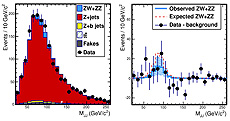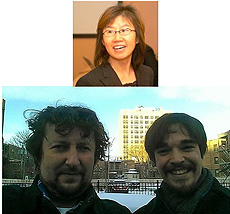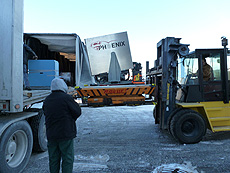|
Thursday, Jan. 30
- Breakfast: Canadian bacon, egg and cheese Texas toast
- Breakfast: Greek omelet
- Ranch house steak sandwich
- Asian beef and vegetables
- Chicken cacciatore
- Italian loaf sandwich
- Tex-Mex grilled-chicken sandwich
- Chicken noodle soup
- Chef's choice soup
- Assorted pizza by the slice
Wilson Hall Cafe menu |
|
Friday, Jan. 31
Dinner
Closed
Wednesday, Feb. 5
Lunch
- Chicken roulade with herbed cheese
- Spinach orzo
- Swedish apple pie
Chez Leon menu
Call x3524 to make your reservation.
|
|
All-hands meeting - Feb. 6 in Ramsey Auditorium
Please plan to attend an all-hands meeting on Thursday, Feb. 6, at 10:30 a.m. in Ramsey Auditorium. (Note the time change from 10 a.m.) Topics will include the FY14 budget and the lab's current and future projects and programs. The meeting will be streamed live.
|
P5 virtual town hall meeting - Feb. 6 in One West
The P5 committee will hold its second virtual town hall meeting on Thursday, Feb. 6, from 9-10:30 a.m. Central time. Scientists at Fermilab who wish to participate are invited to join the meeting from One West.
The meeting will begin with a brief P5 status update and will follow the same format as the first virtual meeting, which took place in January.
The virtual town hall is open to anyone working in particle physics. If you plan to participate from off site, be sure to register. More information is available on the registration site. |
February wellness offerings, fitness classes and discounts
Free wellness offerings include Yoga Trial Days on Feb. 3 and 6 and BuZheng Qigong and Tai Chi Easy classes. Sign up for Yoga on 15 (we have a new instructor), Strength Training by Bod Squad and Kyuki-Do martial arts. Learn more about indoor soccer and employee discounts for February.
Free Wellness Offerings
Free yoga classes Feb. 3, 6
Are you new to yoga, or do you want to learn more about it? Our new instructor will be available to answer your questions at noon on the Wilson Hall 15th-floor crossover. Stay for the free intro class from 12:15-12:45 p.m. Attendees get a free fitness towel.
BuZheng Qigong and Tai Chi Easy
Mondays and Fridays, through May 30, noon-1 p.m.
Ramsey Auditorium
Wednesdays, through May 28, 7-8 a.m.
Ramsey Auditorium
Fitness Classes
Yoga on 15
Mondays, Feb. 10 - March 24 (no class March 17), noon-12:45 p.m.
Wilson Hall 15th-floor crossover
$45/person. Register by Feb. 3
Thursdays, Feb. 13 - March 27 (no class March 20), noon-12:45 p.m.
Wilson Hall 15th-floor crossover
$45/person. Register by Feb. 6
Strength Training by Bod Squad
Tuesdays and Thursdays, Feb. 13 - April 10 (no class March 27), 5-6 p.m.
Fitness Center Exercise Room
$82/person. Register by Feb. 6
Kyuki-Do
Mondays and Wednesdays, Feb. 17 - March 26, 5-6 p.m.
Fitness Center Gym
$60/person. Register by Feb. 10
Athletic League
Indoor soccer
Tuesdays and Thursdays, 6 p.m.
Fitness Center Gym
Gym membership is required to participate. Contact O'Sheg Oshinowo for more information.
Employee discounts
North Aurora Dental Associates
Vaughan Athletic Center corporate rate for Fermilab
For other discount information, visit the WDRS employee discounts Web page.
For more information, contact Jeanne Ecker in the Wellness Office at x2548 or at jecker@fnal.gov.
|
Deepest underground dark-matter detector to start up in China
From IEEE Spectrum, Jan. 29, 2014
In the heart of a mountain in China's Sichuan province, underneath 2400 meters of stone, researchers are powering up the most ambitious effort yet to directly detect some of the strangest stuff in the universe: dark matter. Early this year, the PandaX (Particle and Astrophysical Xenon) experiment will start collecting data in hopes of finding evidence of the elusive particles, thought to constitute more than 80 percent of the matter in the universe.
Read more
|
Squarks and neutralinos lurk in the universe, physicist says
From LiveScience, Jan. 14, 2014
LONDON — Squarks, selectrons and neutralinos may be lurking in the universe, say physicists who suggest supersymmetry — the idea that every known particle has a yet-to-be-discovered sister particle — is not dead, despite the lack of evidence found in its favor.
The world's most powerful atom smasher, the Large Hadron Collider (LHC), has yet to find evidence of the existence of such sparticles (supersymmetric particles), though perhaps physicists are not interpreting the data in the right way, said particle theorist Ben Allanach of Cambridge University.
Speaking here at the Royal Society conference "Before, behind and beyond the discovery of the Higgs Boson" on Tuesday (Jan. 21), Allanach proposed that the LHC might detect the elusive supersymmetric particles once it is up and running again next year with much higher energies.
Read more
|
|
Gluon jets contain more color than quark jets
 |
| The plot shows the number of events as a function of the dijet invariant mass for the dilepton plus dijet selection. There are three channels, and the channel with the most quark-like jets is shown (quark-tagged events). Fit results are overlaid for the ZW and ZZ processes. |
Quarks, the particles that make up nuclear matter, and gluons, the particles that mediate the strong force that holds nuclei together, share an important property: they both have "color." Color, in particle physics, is like the strong force's version of electric charge, but it can be a bit stranger. For instance, particles with color can't live very long on their own. So when quarks and gluons are produced in particle colliders like Fermilab's Tevatron, they form a stream of more stable, color-neutral particles that particle physicists call jets. These jets are then detected by calorimeters, which measure their energy and other properties.
While they look similar at first glance, quark jets and gluon jets are actually different in appearance. Because gluons have a little more color than quarks, gluon jets tend to have more particles in them and thus tend to be wider than quark jets. These properties can make studying jets more difficult: The algorithm for finding jets can capture more of the particles in the narrower quark jets and so lead to better energy measurements of quarks over gluons. But physicists can use these same characteristics
to try to tell the difference between quark and gluon jets, which is important when searching for new processes that should create either quarks or gluons, but not both.
That is exactly what physicists searching for the rare production of boson pairs at CDF did. They wanted to find proton-antiproton collisions where a W or Z boson was produced and decayed into a pair of quarks, producing two quark jets alongside another Z boson that decayed into more easily identifiable electrons or muons. In order to better pick out events with two jets originating from quarks, they developed a new variable that separates quark jets from gluon jets by looking at things such as the spatial spread of the jet. By reducing more of their gluon jet background, they increased their sensitivity to the W and Z bosons they were looking for. Also, to better model their backgrounds, they found ways to calibrate their measurements of the jets' energies based on the type of particles — quarks or gluons — that created them.
By looking at the full Tevatron Run II data set (8.9 inverse femtobarns), CDF physicists have determined the production cross section for ZW and ZZ boson pairs. They measured a cross section σ{ZW +ZZ} = 2.5 +2.0 / -1.0 picobarns, a result that is consistent with the Standard Model prediction of 5.1 picobarns.
Learn more
—edited by Wesley Ketchum and Andy Beretvas
 |
| These physicists were responsible for this analysis: Top row: Young-Kee Kim, University of Chicago.
Second row, from left: Vadim Rusu, Fermilab, and Wesley Ketchum, University of Chicago.
|
|
The S means it's super
 |
| Todd Nebel of the Fermilab Test Beam Facility helps unload the prototype hadronic calorimeter built by the PHENIX collaboration at Brookhaven National Laboratory's Relativistic Heavy Ion Collider as part of the sPHENIX upgrade proposal. The calorimeter, shipped from Brookhaven on Jan. 21 and to be used in the T-1044 test experiment, is a five-ton steel-scintillator calorimeter that is read out using silicon photomultipliers. The sPHENIX experiment is designed to measure jet energy loss in heavy-ion collisions to characterize the quark gluon plasma near the transition temperature.
Photo: John Haggerty, Brookhaven National Laboratory |
|
|